Destination Management: Features, Resources, and Benefits
VerifiedAdded on 2022/12/17
|19
|5865
|90
AI Summary
This report discusses the features and characteristics of global destinations, the core resources and attractions for global destinations, and the concept of destination management along with its benefits and objectives. It also analyzes the function and performance of destination management at national, regional, and local levels.
Contribute Materials
Your contribution can guide someone’s learning journey. Share your
documents today.

Destination
management services
management services
Secure Best Marks with AI Grader
Need help grading? Try our AI Grader for instant feedback on your assignments.
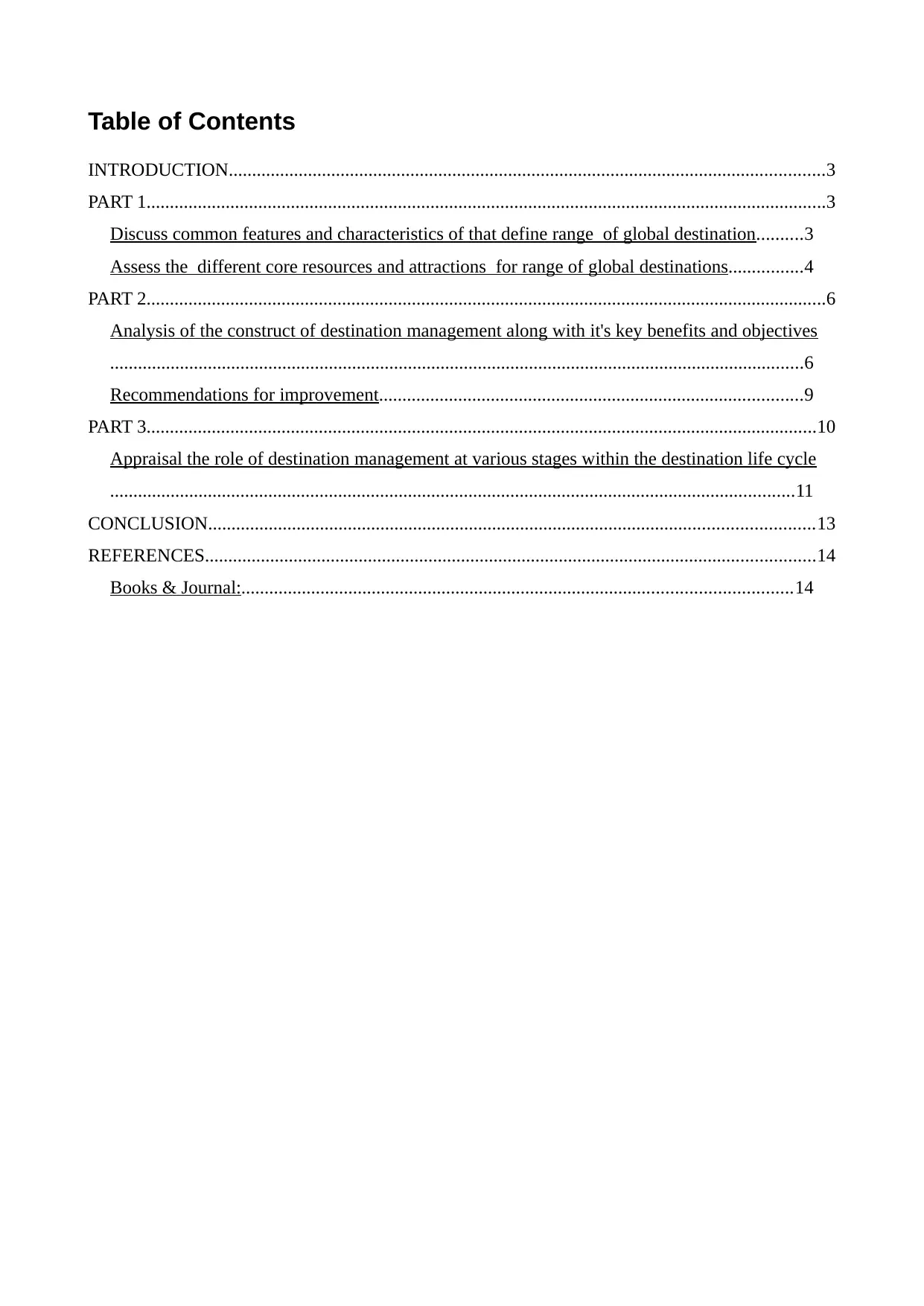
Table of Contents
INTRODUCTION................................................................................................................................3
PART 1..................................................................................................................................................3
Discuss common features and characteristics of that define range of global destination..........3
Assess the different core resources and attractions for range of global destinations................4
PART 2..................................................................................................................................................6
Analysis of the construct of destination management along with it's key benefits and objectives
.....................................................................................................................................................6
Recommendations for improvement...........................................................................................9
PART 3................................................................................................................................................10
Appraisal the role of destination management at various stages within the destination life cycle
...................................................................................................................................................11
CONCLUSION..................................................................................................................................13
REFERENCES...................................................................................................................................14
Books & Journal:......................................................................................................................14
INTRODUCTION................................................................................................................................3
PART 1..................................................................................................................................................3
Discuss common features and characteristics of that define range of global destination..........3
Assess the different core resources and attractions for range of global destinations................4
PART 2..................................................................................................................................................6
Analysis of the construct of destination management along with it's key benefits and objectives
.....................................................................................................................................................6
Recommendations for improvement...........................................................................................9
PART 3................................................................................................................................................10
Appraisal the role of destination management at various stages within the destination life cycle
...................................................................................................................................................11
CONCLUSION..................................................................................................................................13
REFERENCES...................................................................................................................................14
Books & Journal:......................................................................................................................14
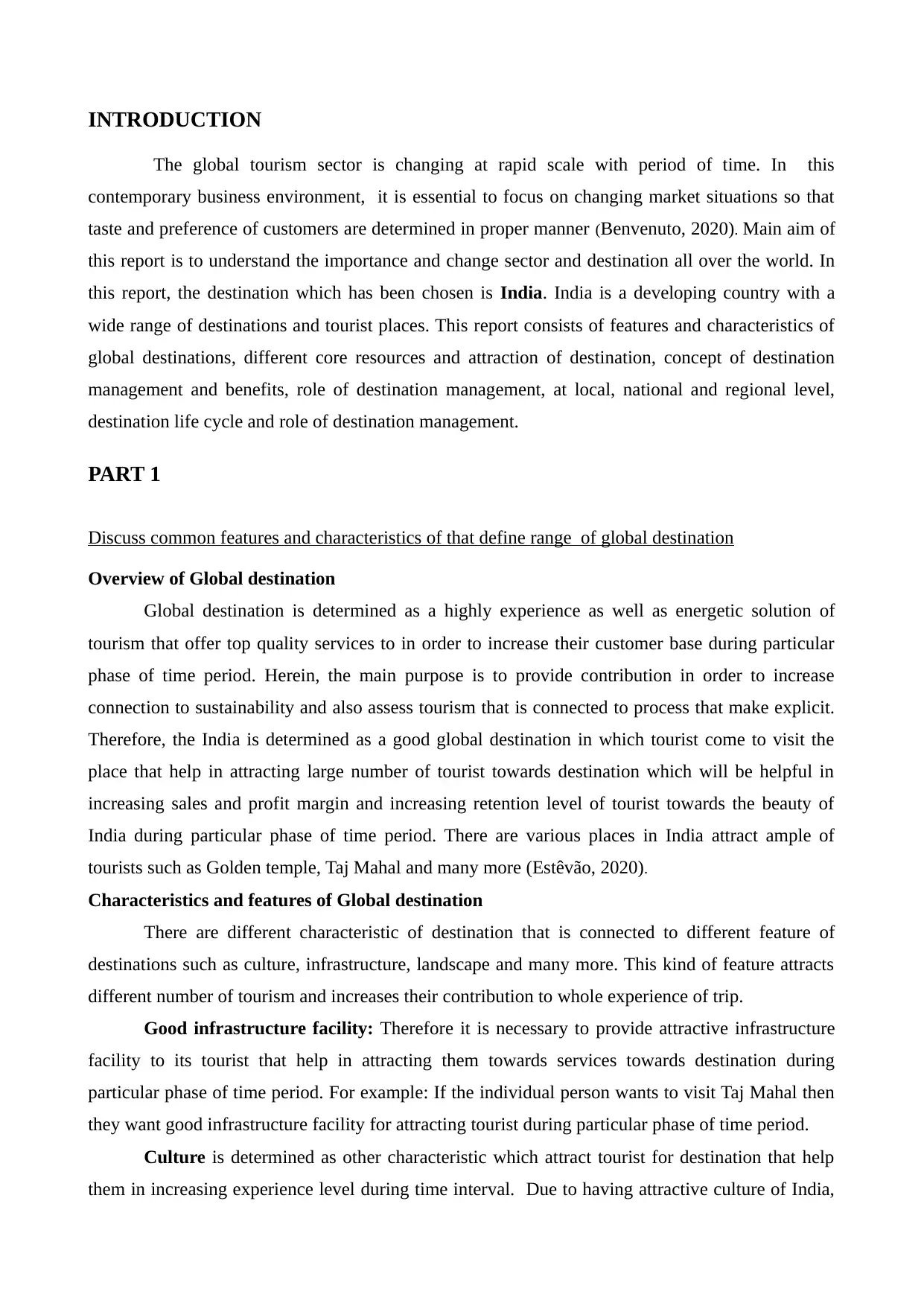
INTRODUCTION
The global tourism sector is changing at rapid scale with period of time. In this
contemporary business environment, it is essential to focus on changing market situations so that
taste and preference of customers are determined in proper manner (Benvenuto, 2020). Main aim of
this report is to understand the importance and change sector and destination all over the world. In
this report, the destination which has been chosen is India. India is a developing country with a
wide range of destinations and tourist places. This report consists of features and characteristics of
global destinations, different core resources and attraction of destination, concept of destination
management and benefits, role of destination management, at local, national and regional level,
destination life cycle and role of destination management.
PART 1
Discuss common features and characteristics of that define range of global destination
Overview of Global destination
Global destination is determined as a highly experience as well as energetic solution of
tourism that offer top quality services to in order to increase their customer base during particular
phase of time period. Herein, the main purpose is to provide contribution in order to increase
connection to sustainability and also assess tourism that is connected to process that make explicit.
Therefore, the India is determined as a good global destination in which tourist come to visit the
place that help in attracting large number of tourist towards destination which will be helpful in
increasing sales and profit margin and increasing retention level of tourist towards the beauty of
India during particular phase of time period. There are various places in India attract ample of
tourists such as Golden temple, Taj Mahal and many more (Estêvão, 2020).
Characteristics and features of Global destination
There are different characteristic of destination that is connected to different feature of
destinations such as culture, infrastructure, landscape and many more. This kind of feature attracts
different number of tourism and increases their contribution to whole experience of trip.
Good infrastructure facility: Therefore it is necessary to provide attractive infrastructure
facility to its tourist that help in attracting them towards services towards destination during
particular phase of time period. For example: If the individual person wants to visit Taj Mahal then
they want good infrastructure facility for attracting tourist during particular phase of time period.
Culture is determined as other characteristic which attract tourist for destination that help
them in increasing experience level during time interval. Due to having attractive culture of India,
The global tourism sector is changing at rapid scale with period of time. In this
contemporary business environment, it is essential to focus on changing market situations so that
taste and preference of customers are determined in proper manner (Benvenuto, 2020). Main aim of
this report is to understand the importance and change sector and destination all over the world. In
this report, the destination which has been chosen is India. India is a developing country with a
wide range of destinations and tourist places. This report consists of features and characteristics of
global destinations, different core resources and attraction of destination, concept of destination
management and benefits, role of destination management, at local, national and regional level,
destination life cycle and role of destination management.
PART 1
Discuss common features and characteristics of that define range of global destination
Overview of Global destination
Global destination is determined as a highly experience as well as energetic solution of
tourism that offer top quality services to in order to increase their customer base during particular
phase of time period. Herein, the main purpose is to provide contribution in order to increase
connection to sustainability and also assess tourism that is connected to process that make explicit.
Therefore, the India is determined as a good global destination in which tourist come to visit the
place that help in attracting large number of tourist towards destination which will be helpful in
increasing sales and profit margin and increasing retention level of tourist towards the beauty of
India during particular phase of time period. There are various places in India attract ample of
tourists such as Golden temple, Taj Mahal and many more (Estêvão, 2020).
Characteristics and features of Global destination
There are different characteristic of destination that is connected to different feature of
destinations such as culture, infrastructure, landscape and many more. This kind of feature attracts
different number of tourism and increases their contribution to whole experience of trip.
Good infrastructure facility: Therefore it is necessary to provide attractive infrastructure
facility to its tourist that help in attracting them towards services towards destination during
particular phase of time period. For example: If the individual person wants to visit Taj Mahal then
they want good infrastructure facility for attracting tourist during particular phase of time period.
Culture is determined as other characteristic which attract tourist for destination that help
them in increasing experience level during time interval. Due to having attractive culture of India,
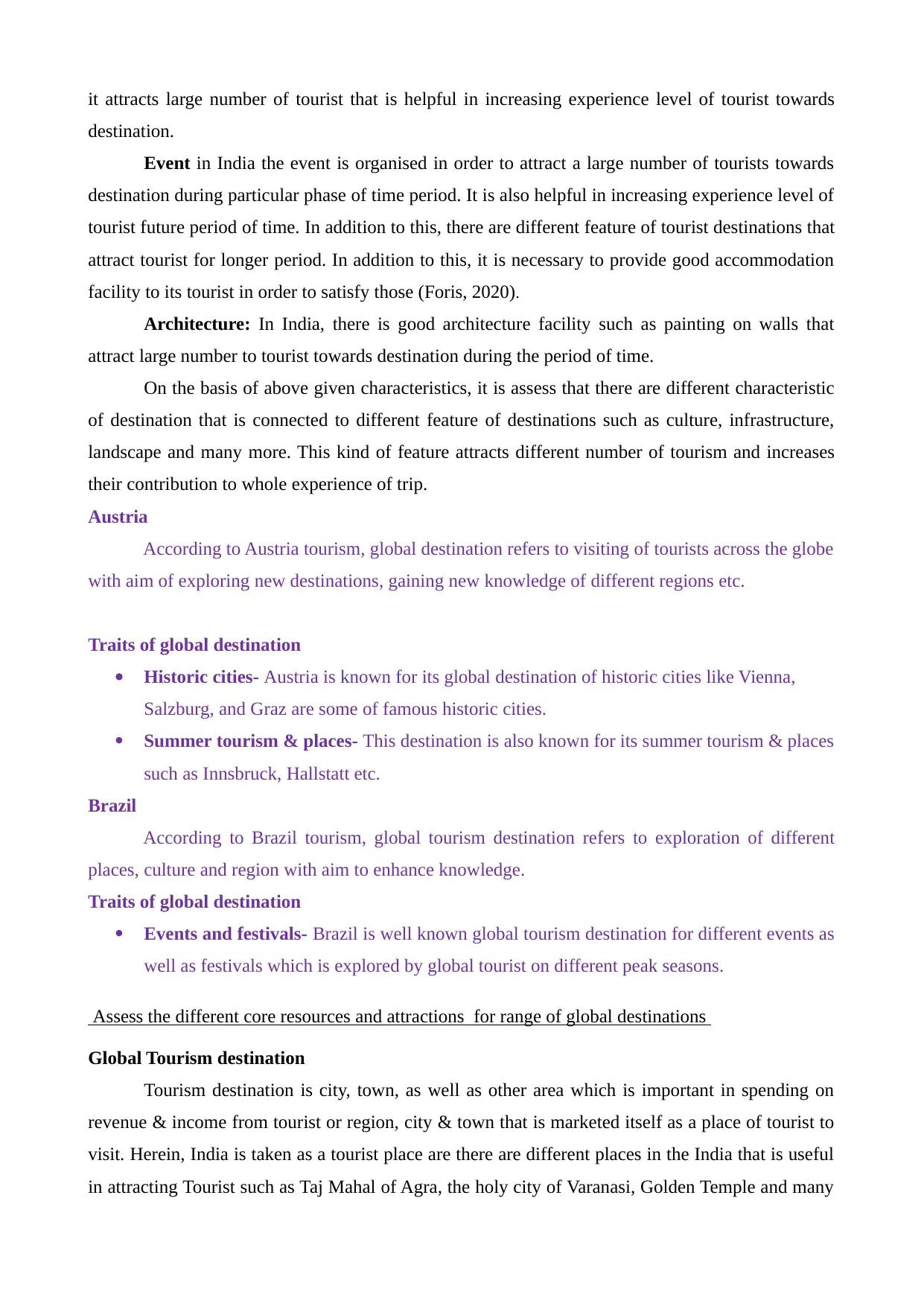
it attracts large number of tourist that is helpful in increasing experience level of tourist towards
destination.
Event in India the event is organised in order to attract a large number of tourists towards
destination during particular phase of time period. It is also helpful in increasing experience level of
tourist future period of time. In addition to this, there are different feature of tourist destinations that
attract tourist for longer period. In addition to this, it is necessary to provide good accommodation
facility to its tourist in order to satisfy those (Foris, 2020).
Architecture: In India, there is good architecture facility such as painting on walls that
attract large number to tourist towards destination during the period of time.
On the basis of above given characteristics, it is assess that there are different characteristic
of destination that is connected to different feature of destinations such as culture, infrastructure,
landscape and many more. This kind of feature attracts different number of tourism and increases
their contribution to whole experience of trip.
Austria
According to Austria tourism, global destination refers to visiting of tourists across the globe
with aim of exploring new destinations, gaining new knowledge of different regions etc.
Traits of global destination
Historic cities- Austria is known for its global destination of historic cities like Vienna,
Salzburg, and Graz are some of famous historic cities.
Summer tourism & places- This destination is also known for its summer tourism & places
such as Innsbruck, Hallstatt etc.
Brazil
According to Brazil tourism, global tourism destination refers to exploration of different
places, culture and region with aim to enhance knowledge.
Traits of global destination
Events and festivals- Brazil is well known global tourism destination for different events as
well as festivals which is explored by global tourist on different peak seasons.
Assess the different core resources and attractions for range of global destinations
Global Tourism destination
Tourism destination is city, town, as well as other area which is important in spending on
revenue & income from tourist or region, city & town that is marketed itself as a place of tourist to
visit. Herein, India is taken as a tourist place are there are different places in the India that is useful
in attracting Tourist such as Taj Mahal of Agra, the holy city of Varanasi, Golden Temple and many
destination.
Event in India the event is organised in order to attract a large number of tourists towards
destination during particular phase of time period. It is also helpful in increasing experience level of
tourist future period of time. In addition to this, there are different feature of tourist destinations that
attract tourist for longer period. In addition to this, it is necessary to provide good accommodation
facility to its tourist in order to satisfy those (Foris, 2020).
Architecture: In India, there is good architecture facility such as painting on walls that
attract large number to tourist towards destination during the period of time.
On the basis of above given characteristics, it is assess that there are different characteristic
of destination that is connected to different feature of destinations such as culture, infrastructure,
landscape and many more. This kind of feature attracts different number of tourism and increases
their contribution to whole experience of trip.
Austria
According to Austria tourism, global destination refers to visiting of tourists across the globe
with aim of exploring new destinations, gaining new knowledge of different regions etc.
Traits of global destination
Historic cities- Austria is known for its global destination of historic cities like Vienna,
Salzburg, and Graz are some of famous historic cities.
Summer tourism & places- This destination is also known for its summer tourism & places
such as Innsbruck, Hallstatt etc.
Brazil
According to Brazil tourism, global tourism destination refers to exploration of different
places, culture and region with aim to enhance knowledge.
Traits of global destination
Events and festivals- Brazil is well known global tourism destination for different events as
well as festivals which is explored by global tourist on different peak seasons.
Assess the different core resources and attractions for range of global destinations
Global Tourism destination
Tourism destination is city, town, as well as other area which is important in spending on
revenue & income from tourist or region, city & town that is marketed itself as a place of tourist to
visit. Herein, India is taken as a tourist place are there are different places in the India that is useful
in attracting Tourist such as Taj Mahal of Agra, the holy city of Varanasi, Golden Temple and many
Secure Best Marks with AI Grader
Need help grading? Try our AI Grader for instant feedback on your assignments.
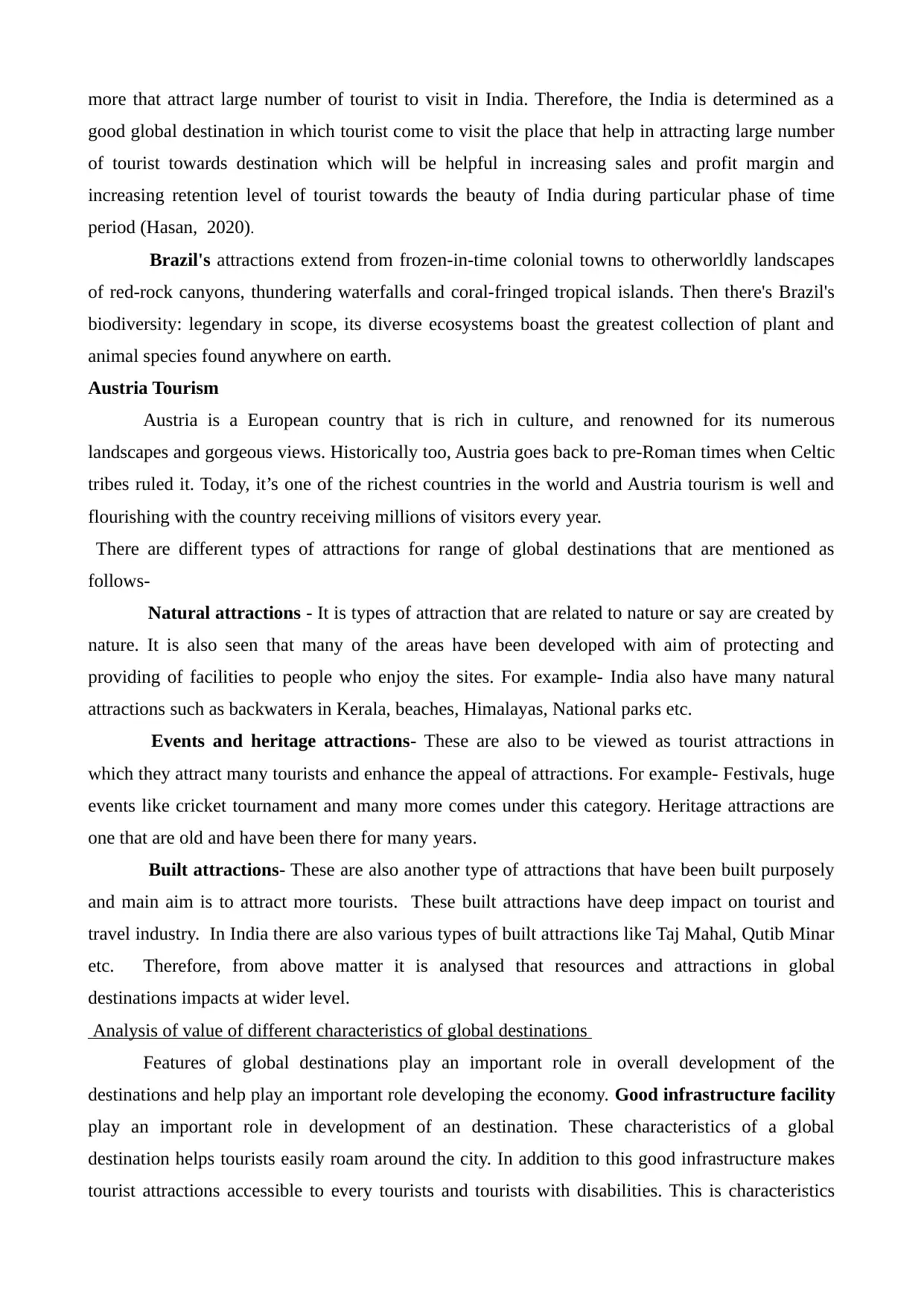
more that attract large number of tourist to visit in India. Therefore, the India is determined as a
good global destination in which tourist come to visit the place that help in attracting large number
of tourist towards destination which will be helpful in increasing sales and profit margin and
increasing retention level of tourist towards the beauty of India during particular phase of time
period (Hasan, 2020).
Brazil's attractions extend from frozen-in-time colonial towns to otherworldly landscapes
of red-rock canyons, thundering waterfalls and coral-fringed tropical islands. Then there's Brazil's
biodiversity: legendary in scope, its diverse ecosystems boast the greatest collection of plant and
animal species found anywhere on earth.
Austria Tourism
Austria is a European country that is rich in culture, and renowned for its numerous
landscapes and gorgeous views. Historically too, Austria goes back to pre-Roman times when Celtic
tribes ruled it. Today, it’s one of the richest countries in the world and Austria tourism is well and
flourishing with the country receiving millions of visitors every year.
There are different types of attractions for range of global destinations that are mentioned as
follows-
Natural attractions - It is types of attraction that are related to nature or say are created by
nature. It is also seen that many of the areas have been developed with aim of protecting and
providing of facilities to people who enjoy the sites. For example- India also have many natural
attractions such as backwaters in Kerala, beaches, Himalayas, National parks etc.
Events and heritage attractions- These are also to be viewed as tourist attractions in
which they attract many tourists and enhance the appeal of attractions. For example- Festivals, huge
events like cricket tournament and many more comes under this category. Heritage attractions are
one that are old and have been there for many years.
Built attractions- These are also another type of attractions that have been built purposely
and main aim is to attract more tourists. These built attractions have deep impact on tourist and
travel industry. In India there are also various types of built attractions like Taj Mahal, Qutib Minar
etc. Therefore, from above matter it is analysed that resources and attractions in global
destinations impacts at wider level.
Analysis of value of different characteristics of global destinations
Features of global destinations play an important role in overall development of the
destinations and help play an important role developing the economy. Good infrastructure facility
play an important role in development of an destination. These characteristics of a global
destination helps tourists easily roam around the city. In addition to this good infrastructure makes
tourist attractions accessible to every tourists and tourists with disabilities. This is characteristics
good global destination in which tourist come to visit the place that help in attracting large number
of tourist towards destination which will be helpful in increasing sales and profit margin and
increasing retention level of tourist towards the beauty of India during particular phase of time
period (Hasan, 2020).
Brazil's attractions extend from frozen-in-time colonial towns to otherworldly landscapes
of red-rock canyons, thundering waterfalls and coral-fringed tropical islands. Then there's Brazil's
biodiversity: legendary in scope, its diverse ecosystems boast the greatest collection of plant and
animal species found anywhere on earth.
Austria Tourism
Austria is a European country that is rich in culture, and renowned for its numerous
landscapes and gorgeous views. Historically too, Austria goes back to pre-Roman times when Celtic
tribes ruled it. Today, it’s one of the richest countries in the world and Austria tourism is well and
flourishing with the country receiving millions of visitors every year.
There are different types of attractions for range of global destinations that are mentioned as
follows-
Natural attractions - It is types of attraction that are related to nature or say are created by
nature. It is also seen that many of the areas have been developed with aim of protecting and
providing of facilities to people who enjoy the sites. For example- India also have many natural
attractions such as backwaters in Kerala, beaches, Himalayas, National parks etc.
Events and heritage attractions- These are also to be viewed as tourist attractions in
which they attract many tourists and enhance the appeal of attractions. For example- Festivals, huge
events like cricket tournament and many more comes under this category. Heritage attractions are
one that are old and have been there for many years.
Built attractions- These are also another type of attractions that have been built purposely
and main aim is to attract more tourists. These built attractions have deep impact on tourist and
travel industry. In India there are also various types of built attractions like Taj Mahal, Qutib Minar
etc. Therefore, from above matter it is analysed that resources and attractions in global
destinations impacts at wider level.
Analysis of value of different characteristics of global destinations
Features of global destinations play an important role in overall development of the
destinations and help play an important role developing the economy. Good infrastructure facility
play an important role in development of an destination. These characteristics of a global
destination helps tourists easily roam around the city. In addition to this good infrastructure makes
tourist attractions accessible to every tourists and tourists with disabilities. This is characteristics
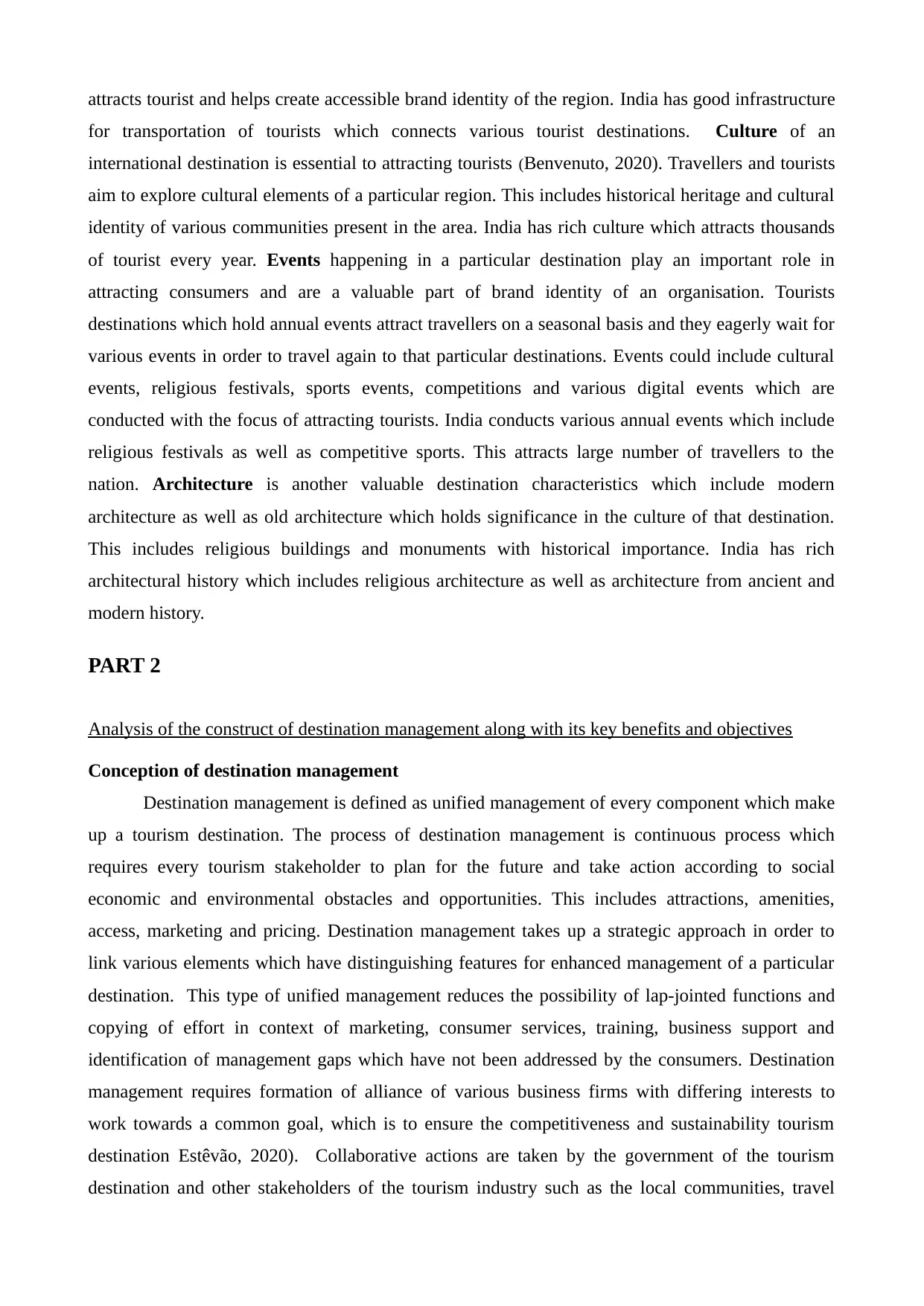
attracts tourist and helps create accessible brand identity of the region. India has good infrastructure
for transportation of tourists which connects various tourist destinations. Culture of an
international destination is essential to attracting tourists (Benvenuto, 2020). Travellers and tourists
aim to explore cultural elements of a particular region. This includes historical heritage and cultural
identity of various communities present in the area. India has rich culture which attracts thousands
of tourist every year. Events happening in a particular destination play an important role in
attracting consumers and are a valuable part of brand identity of an organisation. Tourists
destinations which hold annual events attract travellers on a seasonal basis and they eagerly wait for
various events in order to travel again to that particular destinations. Events could include cultural
events, religious festivals, sports events, competitions and various digital events which are
conducted with the focus of attracting tourists. India conducts various annual events which include
religious festivals as well as competitive sports. This attracts large number of travellers to the
nation. Architecture is another valuable destination characteristics which include modern
architecture as well as old architecture which holds significance in the culture of that destination.
This includes religious buildings and monuments with historical importance. India has rich
architectural history which includes religious architecture as well as architecture from ancient and
modern history.
PART 2
Analysis of the construct of destination management along with its key benefits and objectives
Conception of destination management
Destination management is defined as unified management of every component which make
up a tourism destination. The process of destination management is continuous process which
requires every tourism stakeholder to plan for the future and take action according to social
economic and environmental obstacles and opportunities. This includes attractions, amenities,
access, marketing and pricing. Destination management takes up a strategic approach in order to
link various elements which have distinguishing features for enhanced management of a particular
destination. This type of unified management reduces the possibility of lap-jointed functions and
copying of effort in context of marketing, consumer services, training, business support and
identification of management gaps which have not been addressed by the consumers. Destination
management requires formation of alliance of various business firms with differing interests to
work towards a common goal, which is to ensure the competitiveness and sustainability tourism
destination Estêvão, 2020). Collaborative actions are taken by the government of the tourism
destination and other stakeholders of the tourism industry such as the local communities, travel
for transportation of tourists which connects various tourist destinations. Culture of an
international destination is essential to attracting tourists (Benvenuto, 2020). Travellers and tourists
aim to explore cultural elements of a particular region. This includes historical heritage and cultural
identity of various communities present in the area. India has rich culture which attracts thousands
of tourist every year. Events happening in a particular destination play an important role in
attracting consumers and are a valuable part of brand identity of an organisation. Tourists
destinations which hold annual events attract travellers on a seasonal basis and they eagerly wait for
various events in order to travel again to that particular destinations. Events could include cultural
events, religious festivals, sports events, competitions and various digital events which are
conducted with the focus of attracting tourists. India conducts various annual events which include
religious festivals as well as competitive sports. This attracts large number of travellers to the
nation. Architecture is another valuable destination characteristics which include modern
architecture as well as old architecture which holds significance in the culture of that destination.
This includes religious buildings and monuments with historical importance. India has rich
architectural history which includes religious architecture as well as architecture from ancient and
modern history.
PART 2
Analysis of the construct of destination management along with its key benefits and objectives
Conception of destination management
Destination management is defined as unified management of every component which make
up a tourism destination. The process of destination management is continuous process which
requires every tourism stakeholder to plan for the future and take action according to social
economic and environmental obstacles and opportunities. This includes attractions, amenities,
access, marketing and pricing. Destination management takes up a strategic approach in order to
link various elements which have distinguishing features for enhanced management of a particular
destination. This type of unified management reduces the possibility of lap-jointed functions and
copying of effort in context of marketing, consumer services, training, business support and
identification of management gaps which have not been addressed by the consumers. Destination
management requires formation of alliance of various business firms with differing interests to
work towards a common goal, which is to ensure the competitiveness and sustainability tourism
destination Estêvão, 2020). Collaborative actions are taken by the government of the tourism
destination and other stakeholders of the tourism industry such as the local communities, travel
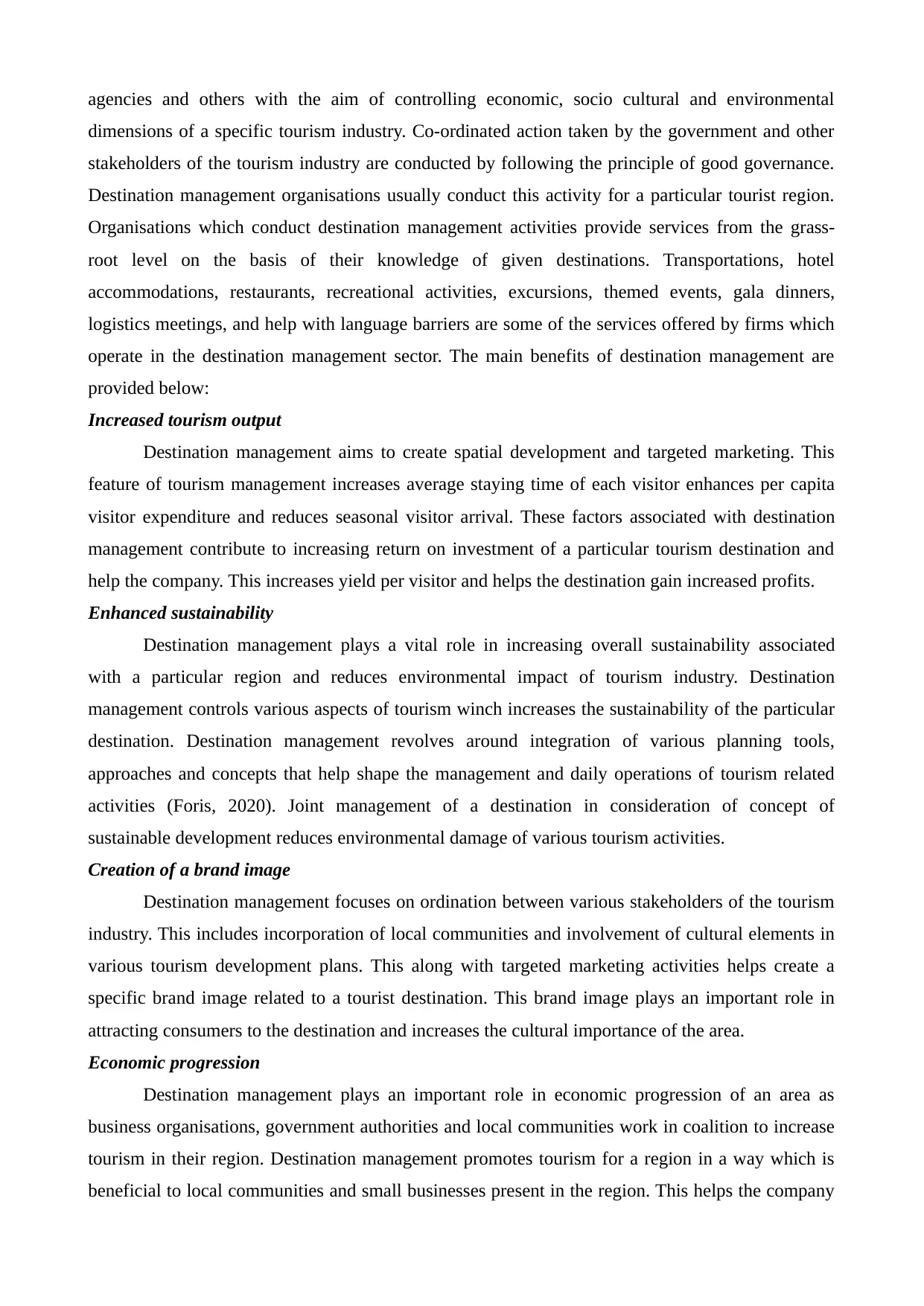
agencies and others with the aim of controlling economic, socio cultural and environmental
dimensions of a specific tourism industry. Co-ordinated action taken by the government and other
stakeholders of the tourism industry are conducted by following the principle of good governance.
Destination management organisations usually conduct this activity for a particular tourist region.
Organisations which conduct destination management activities provide services from the grass-
root level on the basis of their knowledge of given destinations. Transportations, hotel
accommodations, restaurants, recreational activities, excursions, themed events, gala dinners,
logistics meetings, and help with language barriers are some of the services offered by firms which
operate in the destination management sector. The main benefits of destination management are
provided below:
Increased tourism output
Destination management aims to create spatial development and targeted marketing. This
feature of tourism management increases average staying time of each visitor enhances per capita
visitor expenditure and reduces seasonal visitor arrival. These factors associated with destination
management contribute to increasing return on investment of a particular tourism destination and
help the company. This increases yield per visitor and helps the destination gain increased profits.
Enhanced sustainability
Destination management plays a vital role in increasing overall sustainability associated
with a particular region and reduces environmental impact of tourism industry. Destination
management controls various aspects of tourism winch increases the sustainability of the particular
destination. Destination management revolves around integration of various planning tools,
approaches and concepts that help shape the management and daily operations of tourism related
activities (Foris, 2020). Joint management of a destination in consideration of concept of
sustainable development reduces environmental damage of various tourism activities.
Creation of a brand image
Destination management focuses on ordination between various stakeholders of the tourism
industry. This includes incorporation of local communities and involvement of cultural elements in
various tourism development plans. This along with targeted marketing activities helps create a
specific brand image related to a tourist destination. This brand image plays an important role in
attracting consumers to the destination and increases the cultural importance of the area.
Economic progression
Destination management plays an important role in economic progression of an area as
business organisations, government authorities and local communities work in coalition to increase
tourism in their region. Destination management promotes tourism for a region in a way which is
beneficial to local communities and small businesses present in the region. This helps the company
dimensions of a specific tourism industry. Co-ordinated action taken by the government and other
stakeholders of the tourism industry are conducted by following the principle of good governance.
Destination management organisations usually conduct this activity for a particular tourist region.
Organisations which conduct destination management activities provide services from the grass-
root level on the basis of their knowledge of given destinations. Transportations, hotel
accommodations, restaurants, recreational activities, excursions, themed events, gala dinners,
logistics meetings, and help with language barriers are some of the services offered by firms which
operate in the destination management sector. The main benefits of destination management are
provided below:
Increased tourism output
Destination management aims to create spatial development and targeted marketing. This
feature of tourism management increases average staying time of each visitor enhances per capita
visitor expenditure and reduces seasonal visitor arrival. These factors associated with destination
management contribute to increasing return on investment of a particular tourism destination and
help the company. This increases yield per visitor and helps the destination gain increased profits.
Enhanced sustainability
Destination management plays a vital role in increasing overall sustainability associated
with a particular region and reduces environmental impact of tourism industry. Destination
management controls various aspects of tourism winch increases the sustainability of the particular
destination. Destination management revolves around integration of various planning tools,
approaches and concepts that help shape the management and daily operations of tourism related
activities (Foris, 2020). Joint management of a destination in consideration of concept of
sustainable development reduces environmental damage of various tourism activities.
Creation of a brand image
Destination management focuses on ordination between various stakeholders of the tourism
industry. This includes incorporation of local communities and involvement of cultural elements in
various tourism development plans. This along with targeted marketing activities helps create a
specific brand image related to a tourist destination. This brand image plays an important role in
attracting consumers to the destination and increases the cultural importance of the area.
Economic progression
Destination management plays an important role in economic progression of an area as
business organisations, government authorities and local communities work in coalition to increase
tourism in their region. Destination management promotes tourism for a region in a way which is
beneficial to local communities and small businesses present in the region. This helps the company
Paraphrase This Document
Need a fresh take? Get an instant paraphrase of this document with our AI Paraphraser
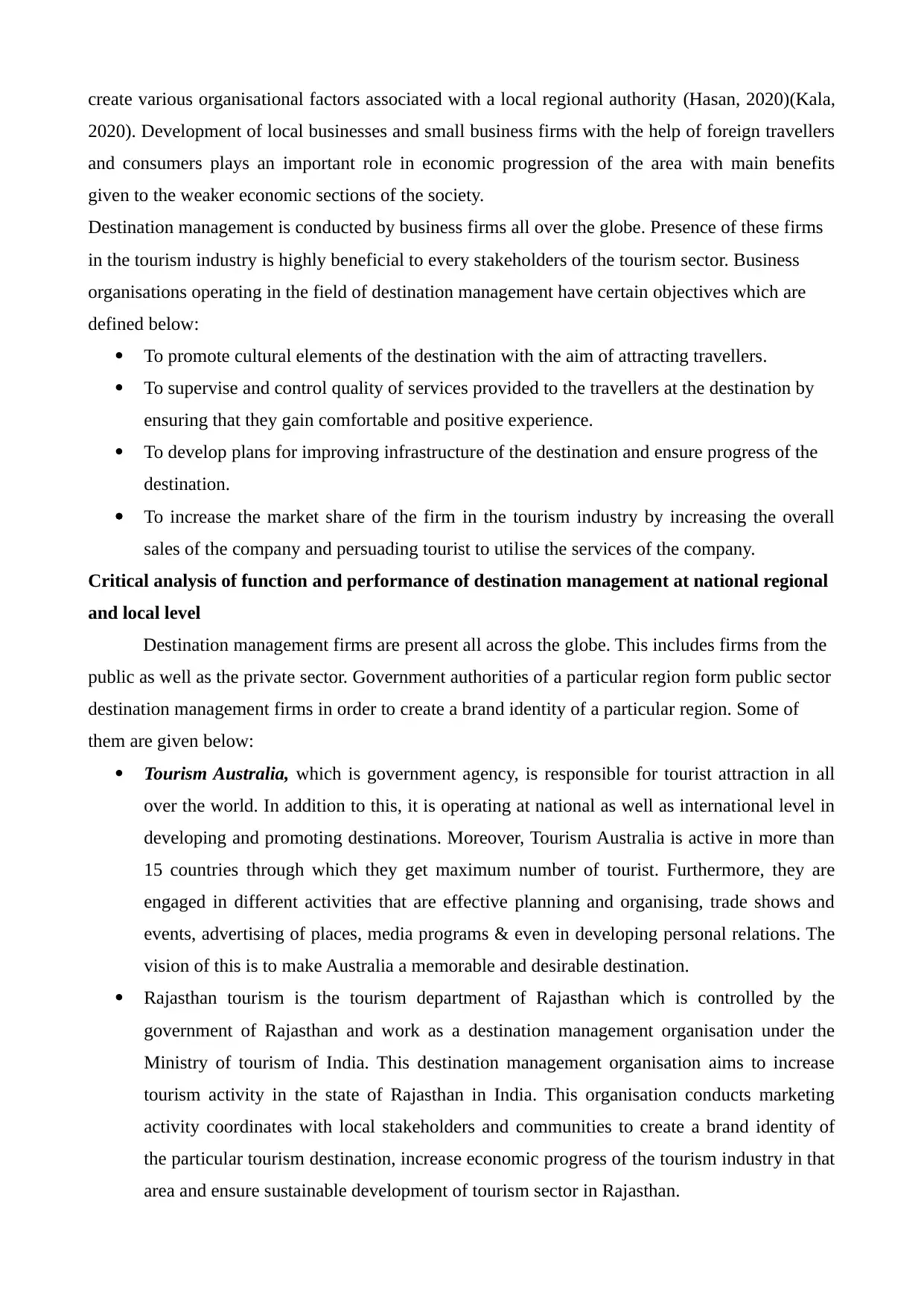
create various organisational factors associated with a local regional authority (Hasan, 2020)(Kala,
2020). Development of local businesses and small business firms with the help of foreign travellers
and consumers plays an important role in economic progression of the area with main benefits
given to the weaker economic sections of the society.
Destination management is conducted by business firms all over the globe. Presence of these firms
in the tourism industry is highly beneficial to every stakeholders of the tourism sector. Business
organisations operating in the field of destination management have certain objectives which are
defined below:
To promote cultural elements of the destination with the aim of attracting travellers.
To supervise and control quality of services provided to the travellers at the destination by
ensuring that they gain comfortable and positive experience.
To develop plans for improving infrastructure of the destination and ensure progress of the
destination.
To increase the market share of the firm in the tourism industry by increasing the overall
sales of the company and persuading tourist to utilise the services of the company.
Critical analysis of function and performance of destination management at national regional
and local level
Destination management firms are present all across the globe. This includes firms from the
public as well as the private sector. Government authorities of a particular region form public sector
destination management firms in order to create a brand identity of a particular region. Some of
them are given below:
Tourism Australia, which is government agency, is responsible for tourist attraction in all
over the world. In addition to this, it is operating at national as well as international level in
developing and promoting destinations. Moreover, Tourism Australia is active in more than
15 countries through which they get maximum number of tourist. Furthermore, they are
engaged in different activities that are effective planning and organising, trade shows and
events, advertising of places, media programs & even in developing personal relations. The
vision of this is to make Australia a memorable and desirable destination.
Rajasthan tourism is the tourism department of Rajasthan which is controlled by the
government of Rajasthan and work as a destination management organisation under the
Ministry of tourism of India. This destination management organisation aims to increase
tourism activity in the state of Rajasthan in India. This organisation conducts marketing
activity coordinates with local stakeholders and communities to create a brand identity of
the particular tourism destination, increase economic progress of the tourism industry in that
area and ensure sustainable development of tourism sector in Rajasthan.
2020). Development of local businesses and small business firms with the help of foreign travellers
and consumers plays an important role in economic progression of the area with main benefits
given to the weaker economic sections of the society.
Destination management is conducted by business firms all over the globe. Presence of these firms
in the tourism industry is highly beneficial to every stakeholders of the tourism sector. Business
organisations operating in the field of destination management have certain objectives which are
defined below:
To promote cultural elements of the destination with the aim of attracting travellers.
To supervise and control quality of services provided to the travellers at the destination by
ensuring that they gain comfortable and positive experience.
To develop plans for improving infrastructure of the destination and ensure progress of the
destination.
To increase the market share of the firm in the tourism industry by increasing the overall
sales of the company and persuading tourist to utilise the services of the company.
Critical analysis of function and performance of destination management at national regional
and local level
Destination management firms are present all across the globe. This includes firms from the
public as well as the private sector. Government authorities of a particular region form public sector
destination management firms in order to create a brand identity of a particular region. Some of
them are given below:
Tourism Australia, which is government agency, is responsible for tourist attraction in all
over the world. In addition to this, it is operating at national as well as international level in
developing and promoting destinations. Moreover, Tourism Australia is active in more than
15 countries through which they get maximum number of tourist. Furthermore, they are
engaged in different activities that are effective planning and organising, trade shows and
events, advertising of places, media programs & even in developing personal relations. The
vision of this is to make Australia a memorable and desirable destination.
Rajasthan tourism is the tourism department of Rajasthan which is controlled by the
government of Rajasthan and work as a destination management organisation under the
Ministry of tourism of India. This destination management organisation aims to increase
tourism activity in the state of Rajasthan in India. This organisation conducts marketing
activity coordinates with local stakeholders and communities to create a brand identity of
the particular tourism destination, increase economic progress of the tourism industry in that
area and ensure sustainable development of tourism sector in Rajasthan.
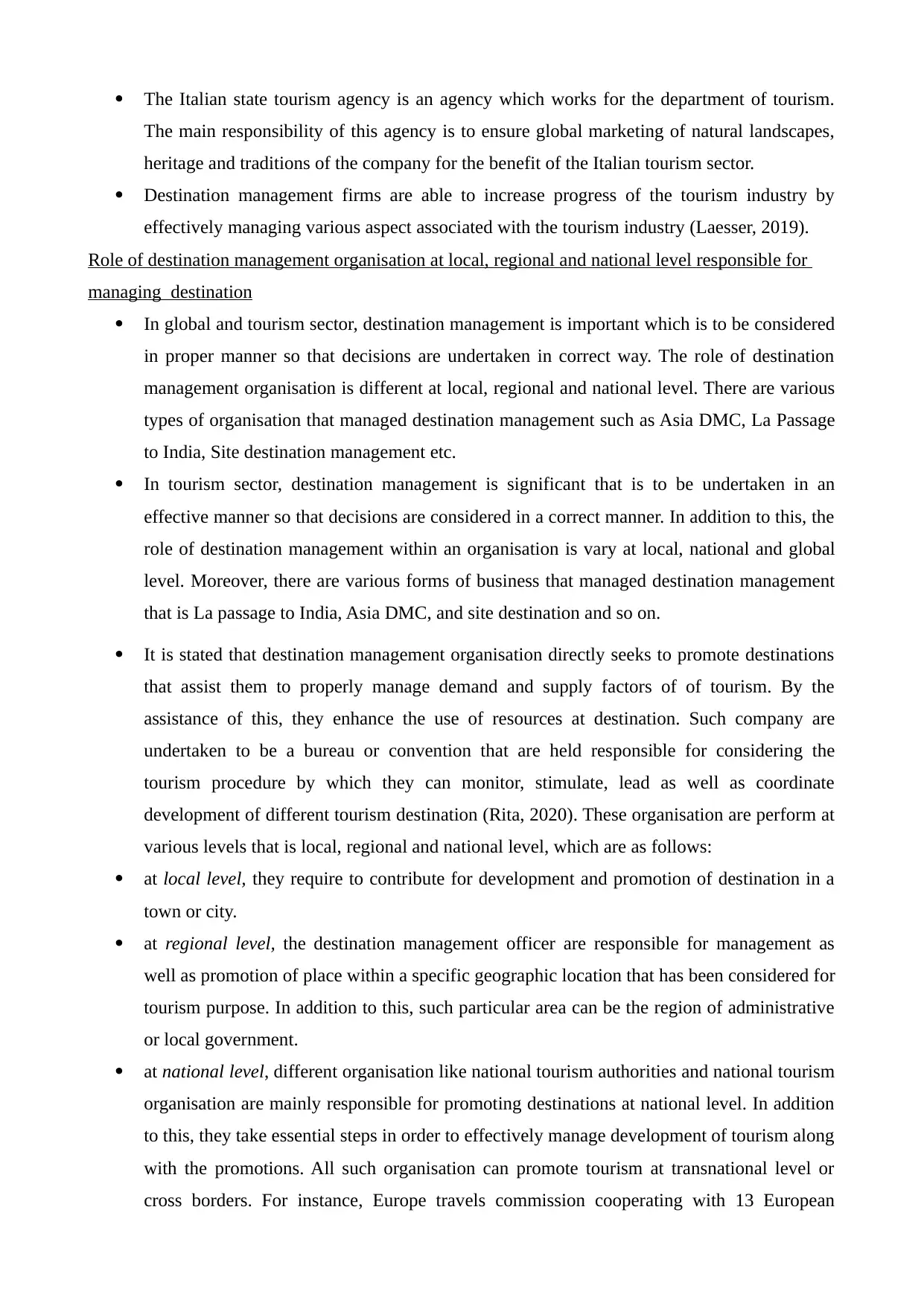
The Italian state tourism agency is an agency which works for the department of tourism.
The main responsibility of this agency is to ensure global marketing of natural landscapes,
heritage and traditions of the company for the benefit of the Italian tourism sector.
Destination management firms are able to increase progress of the tourism industry by
effectively managing various aspect associated with the tourism industry (Laesser, 2019).
Role of destination management organisation at local, regional and national level responsible for
managing destination
In global and tourism sector, destination management is important which is to be considered
in proper manner so that decisions are undertaken in correct way. The role of destination
management organisation is different at local, regional and national level. There are various
types of organisation that managed destination management such as Asia DMC, La Passage
to India, Site destination management etc.
In tourism sector, destination management is significant that is to be undertaken in an
effective manner so that decisions are considered in a correct manner. In addition to this, the
role of destination management within an organisation is vary at local, national and global
level. Moreover, there are various forms of business that managed destination management
that is La passage to India, Asia DMC, and site destination and so on.
It is stated that destination management organisation directly seeks to promote destinations
that assist them to properly manage demand and supply factors of of tourism. By the
assistance of this, they enhance the use of resources at destination. Such company are
undertaken to be a bureau or convention that are held responsible for considering the
tourism procedure by which they can monitor, stimulate, lead as well as coordinate
development of different tourism destination (Rita, 2020). These organisation are perform at
various levels that is local, regional and national level, which are as follows:
at local level, they require to contribute for development and promotion of destination in a
town or city.
at regional level, the destination management officer are responsible for management as
well as promotion of place within a specific geographic location that has been considered for
tourism purpose. In addition to this, such particular area can be the region of administrative
or local government.
at national level, different organisation like national tourism authorities and national tourism
organisation are mainly responsible for promoting destinations at national level. In addition
to this, they take essential steps in order to effectively manage development of tourism along
with the promotions. All such organisation can promote tourism at transnational level or
cross borders. For instance, Europe travels commission cooperating with 13 European
The main responsibility of this agency is to ensure global marketing of natural landscapes,
heritage and traditions of the company for the benefit of the Italian tourism sector.
Destination management firms are able to increase progress of the tourism industry by
effectively managing various aspect associated with the tourism industry (Laesser, 2019).
Role of destination management organisation at local, regional and national level responsible for
managing destination
In global and tourism sector, destination management is important which is to be considered
in proper manner so that decisions are undertaken in correct way. The role of destination
management organisation is different at local, regional and national level. There are various
types of organisation that managed destination management such as Asia DMC, La Passage
to India, Site destination management etc.
In tourism sector, destination management is significant that is to be undertaken in an
effective manner so that decisions are considered in a correct manner. In addition to this, the
role of destination management within an organisation is vary at local, national and global
level. Moreover, there are various forms of business that managed destination management
that is La passage to India, Asia DMC, and site destination and so on.
It is stated that destination management organisation directly seeks to promote destinations
that assist them to properly manage demand and supply factors of of tourism. By the
assistance of this, they enhance the use of resources at destination. Such company are
undertaken to be a bureau or convention that are held responsible for considering the
tourism procedure by which they can monitor, stimulate, lead as well as coordinate
development of different tourism destination (Rita, 2020). These organisation are perform at
various levels that is local, regional and national level, which are as follows:
at local level, they require to contribute for development and promotion of destination in a
town or city.
at regional level, the destination management officer are responsible for management as
well as promotion of place within a specific geographic location that has been considered for
tourism purpose. In addition to this, such particular area can be the region of administrative
or local government.
at national level, different organisation like national tourism authorities and national tourism
organisation are mainly responsible for promoting destinations at national level. In addition
to this, they take essential steps in order to effectively manage development of tourism along
with the promotions. All such organisation can promote tourism at transnational level or
cross borders. For instance, Europe travels commission cooperating with 13 European
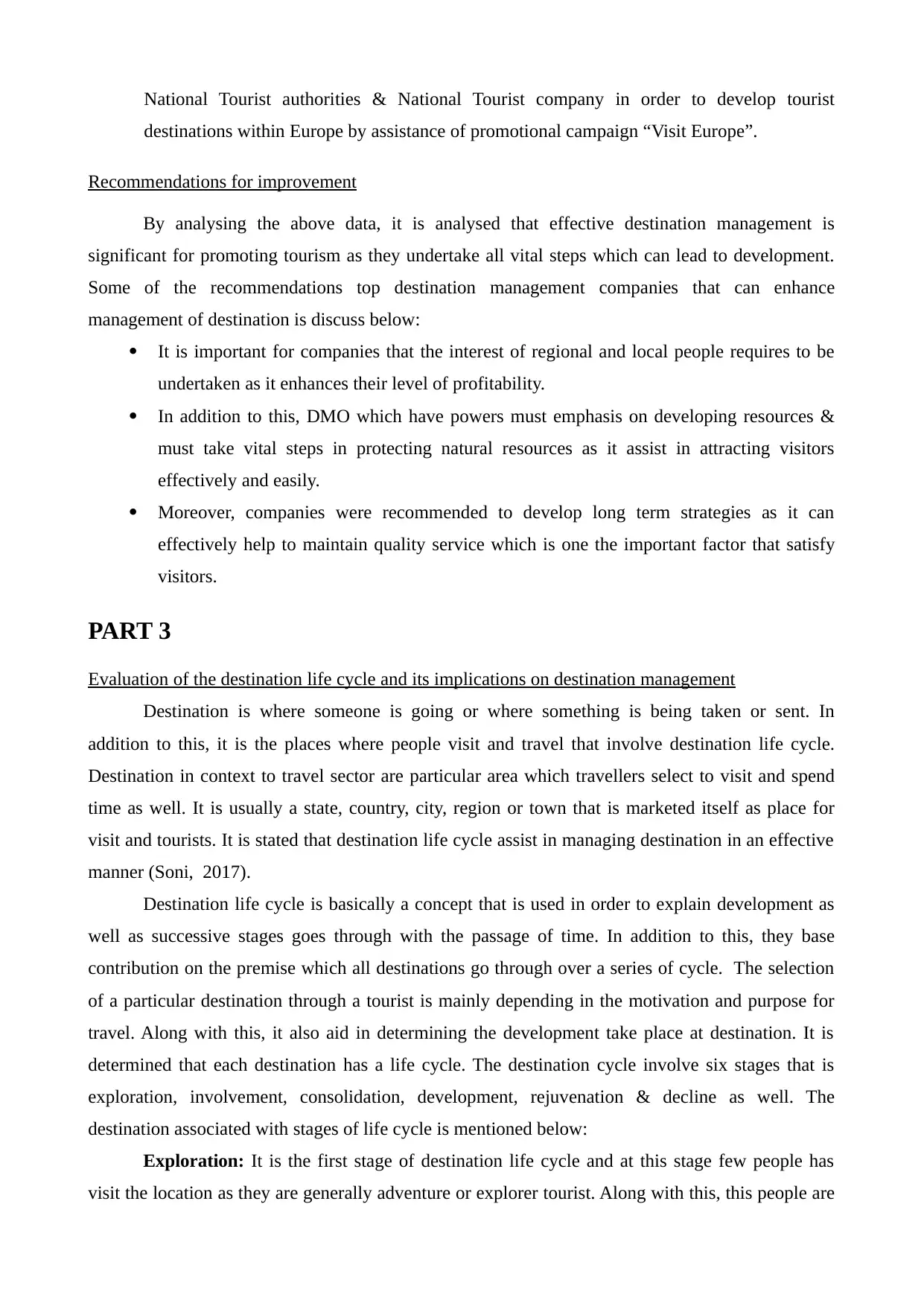
National Tourist authorities & National Tourist company in order to develop tourist
destinations within Europe by assistance of promotional campaign “Visit Europe”.
Recommendations for improvement
By analysing the above data, it is analysed that effective destination management is
significant for promoting tourism as they undertake all vital steps which can lead to development.
Some of the recommendations top destination management companies that can enhance
management of destination is discuss below:
It is important for companies that the interest of regional and local people requires to be
undertaken as it enhances their level of profitability.
In addition to this, DMO which have powers must emphasis on developing resources &
must take vital steps in protecting natural resources as it assist in attracting visitors
effectively and easily.
Moreover, companies were recommended to develop long term strategies as it can
effectively help to maintain quality service which is one the important factor that satisfy
visitors.
PART 3
Evaluation of the destination life cycle and its implications on destination management
Destination is where someone is going or where something is being taken or sent. In
addition to this, it is the places where people visit and travel that involve destination life cycle.
Destination in context to travel sector are particular area which travellers select to visit and spend
time as well. It is usually a state, country, city, region or town that is marketed itself as place for
visit and tourists. It is stated that destination life cycle assist in managing destination in an effective
manner (Soni, 2017).
Destination life cycle is basically a concept that is used in order to explain development as
well as successive stages goes through with the passage of time. In addition to this, they base
contribution on the premise which all destinations go through over a series of cycle. The selection
of a particular destination through a tourist is mainly depending in the motivation and purpose for
travel. Along with this, it also aid in determining the development take place at destination. It is
determined that each destination has a life cycle. The destination cycle involve six stages that is
exploration, involvement, consolidation, development, rejuvenation & decline as well. The
destination associated with stages of life cycle is mentioned below:
Exploration: It is the first stage of destination life cycle and at this stage few people has
visit the location as they are generally adventure or explorer tourist. Along with this, this people are
destinations within Europe by assistance of promotional campaign “Visit Europe”.
Recommendations for improvement
By analysing the above data, it is analysed that effective destination management is
significant for promoting tourism as they undertake all vital steps which can lead to development.
Some of the recommendations top destination management companies that can enhance
management of destination is discuss below:
It is important for companies that the interest of regional and local people requires to be
undertaken as it enhances their level of profitability.
In addition to this, DMO which have powers must emphasis on developing resources &
must take vital steps in protecting natural resources as it assist in attracting visitors
effectively and easily.
Moreover, companies were recommended to develop long term strategies as it can
effectively help to maintain quality service which is one the important factor that satisfy
visitors.
PART 3
Evaluation of the destination life cycle and its implications on destination management
Destination is where someone is going or where something is being taken or sent. In
addition to this, it is the places where people visit and travel that involve destination life cycle.
Destination in context to travel sector are particular area which travellers select to visit and spend
time as well. It is usually a state, country, city, region or town that is marketed itself as place for
visit and tourists. It is stated that destination life cycle assist in managing destination in an effective
manner (Soni, 2017).
Destination life cycle is basically a concept that is used in order to explain development as
well as successive stages goes through with the passage of time. In addition to this, they base
contribution on the premise which all destinations go through over a series of cycle. The selection
of a particular destination through a tourist is mainly depending in the motivation and purpose for
travel. Along with this, it also aid in determining the development take place at destination. It is
determined that each destination has a life cycle. The destination cycle involve six stages that is
exploration, involvement, consolidation, development, rejuvenation & decline as well. The
destination associated with stages of life cycle is mentioned below:
Exploration: It is the first stage of destination life cycle and at this stage few people has
visit the location as they are generally adventure or explorer tourist. Along with this, this people are
Secure Best Marks with AI Grader
Need help grading? Try our AI Grader for instant feedback on your assignments.
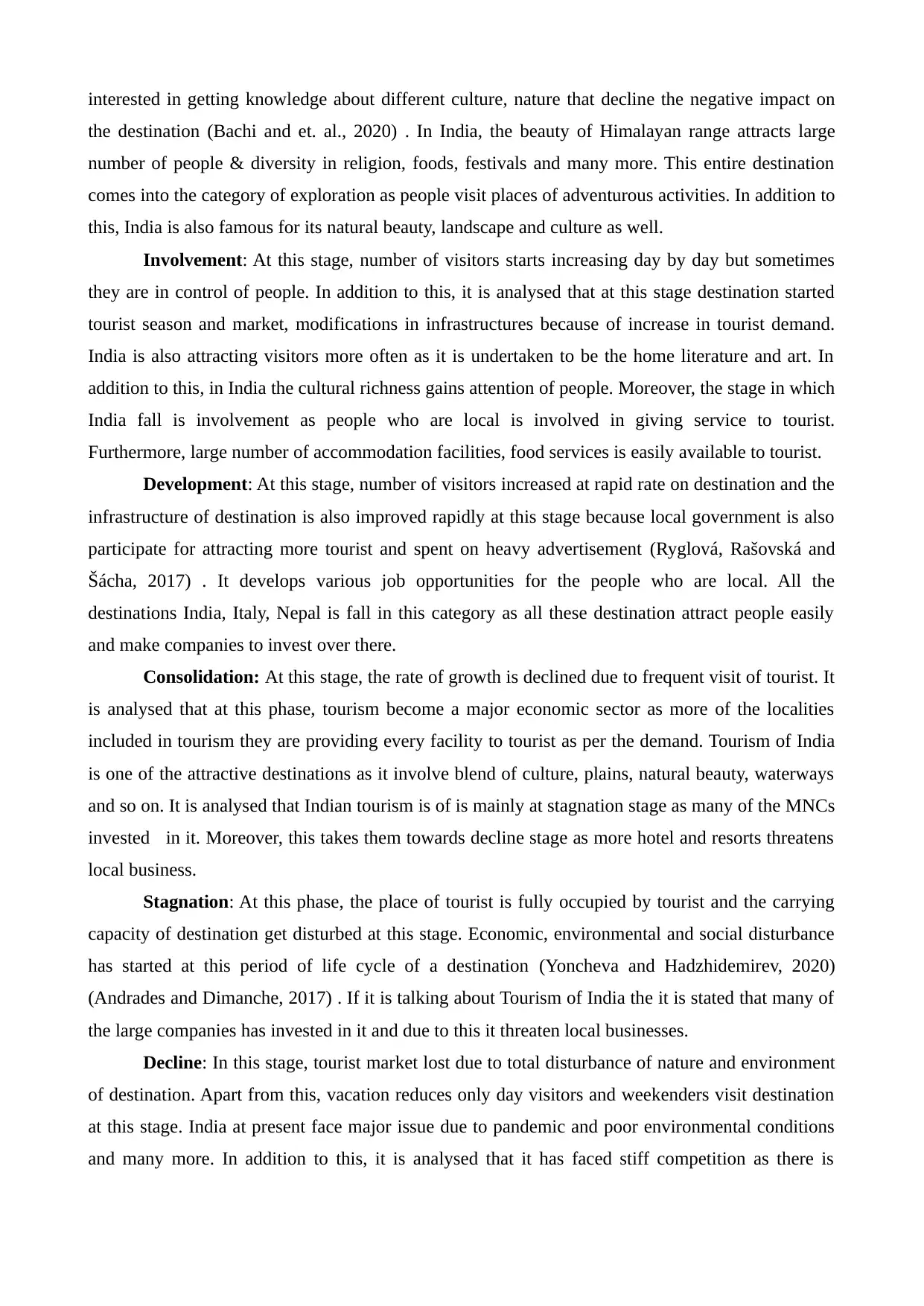
interested in getting knowledge about different culture, nature that decline the negative impact on
the destination (Bachi and et. al., 2020) . In India, the beauty of Himalayan range attracts large
number of people & diversity in religion, foods, festivals and many more. This entire destination
comes into the category of exploration as people visit places of adventurous activities. In addition to
this, India is also famous for its natural beauty, landscape and culture as well.
Involvement: At this stage, number of visitors starts increasing day by day but sometimes
they are in control of people. In addition to this, it is analysed that at this stage destination started
tourist season and market, modifications in infrastructures because of increase in tourist demand.
India is also attracting visitors more often as it is undertaken to be the home literature and art. In
addition to this, in India the cultural richness gains attention of people. Moreover, the stage in which
India fall is involvement as people who are local is involved in giving service to tourist.
Furthermore, large number of accommodation facilities, food services is easily available to tourist.
Development: At this stage, number of visitors increased at rapid rate on destination and the
infrastructure of destination is also improved rapidly at this stage because local government is also
participate for attracting more tourist and spent on heavy advertisement (Ryglová, Rašovská and
Šácha, 2017) . It develops various job opportunities for the people who are local. All the
destinations India, Italy, Nepal is fall in this category as all these destination attract people easily
and make companies to invest over there.
Consolidation: At this stage, the rate of growth is declined due to frequent visit of tourist. It
is analysed that at this phase, tourism become a major economic sector as more of the localities
included in tourism they are providing every facility to tourist as per the demand. Tourism of India
is one of the attractive destinations as it involve blend of culture, plains, natural beauty, waterways
and so on. It is analysed that Indian tourism is of is mainly at stagnation stage as many of the MNCs
invested in it. Moreover, this takes them towards decline stage as more hotel and resorts threatens
local business.
Stagnation: At this phase, the place of tourist is fully occupied by tourist and the carrying
capacity of destination get disturbed at this stage. Economic, environmental and social disturbance
has started at this period of life cycle of a destination (Yoncheva and Hadzhidemirev, 2020)
(Andrades and Dimanche, 2017) . If it is talking about Tourism of India the it is stated that many of
the large companies has invested in it and due to this it threaten local businesses.
Decline: In this stage, tourist market lost due to total disturbance of nature and environment
of destination. Apart from this, vacation reduces only day visitors and weekenders visit destination
at this stage. India at present face major issue due to pandemic and poor environmental conditions
and many more. In addition to this, it is analysed that it has faced stiff competition as there is
the destination (Bachi and et. al., 2020) . In India, the beauty of Himalayan range attracts large
number of people & diversity in religion, foods, festivals and many more. This entire destination
comes into the category of exploration as people visit places of adventurous activities. In addition to
this, India is also famous for its natural beauty, landscape and culture as well.
Involvement: At this stage, number of visitors starts increasing day by day but sometimes
they are in control of people. In addition to this, it is analysed that at this stage destination started
tourist season and market, modifications in infrastructures because of increase in tourist demand.
India is also attracting visitors more often as it is undertaken to be the home literature and art. In
addition to this, in India the cultural richness gains attention of people. Moreover, the stage in which
India fall is involvement as people who are local is involved in giving service to tourist.
Furthermore, large number of accommodation facilities, food services is easily available to tourist.
Development: At this stage, number of visitors increased at rapid rate on destination and the
infrastructure of destination is also improved rapidly at this stage because local government is also
participate for attracting more tourist and spent on heavy advertisement (Ryglová, Rašovská and
Šácha, 2017) . It develops various job opportunities for the people who are local. All the
destinations India, Italy, Nepal is fall in this category as all these destination attract people easily
and make companies to invest over there.
Consolidation: At this stage, the rate of growth is declined due to frequent visit of tourist. It
is analysed that at this phase, tourism become a major economic sector as more of the localities
included in tourism they are providing every facility to tourist as per the demand. Tourism of India
is one of the attractive destinations as it involve blend of culture, plains, natural beauty, waterways
and so on. It is analysed that Indian tourism is of is mainly at stagnation stage as many of the MNCs
invested in it. Moreover, this takes them towards decline stage as more hotel and resorts threatens
local business.
Stagnation: At this phase, the place of tourist is fully occupied by tourist and the carrying
capacity of destination get disturbed at this stage. Economic, environmental and social disturbance
has started at this period of life cycle of a destination (Yoncheva and Hadzhidemirev, 2020)
(Andrades and Dimanche, 2017) . If it is talking about Tourism of India the it is stated that many of
the large companies has invested in it and due to this it threaten local businesses.
Decline: In this stage, tourist market lost due to total disturbance of nature and environment
of destination. Apart from this, vacation reduces only day visitors and weekenders visit destination
at this stage. India at present face major issue due to pandemic and poor environmental conditions
and many more. In addition to this, it is analysed that it has faced stiff competition as there is
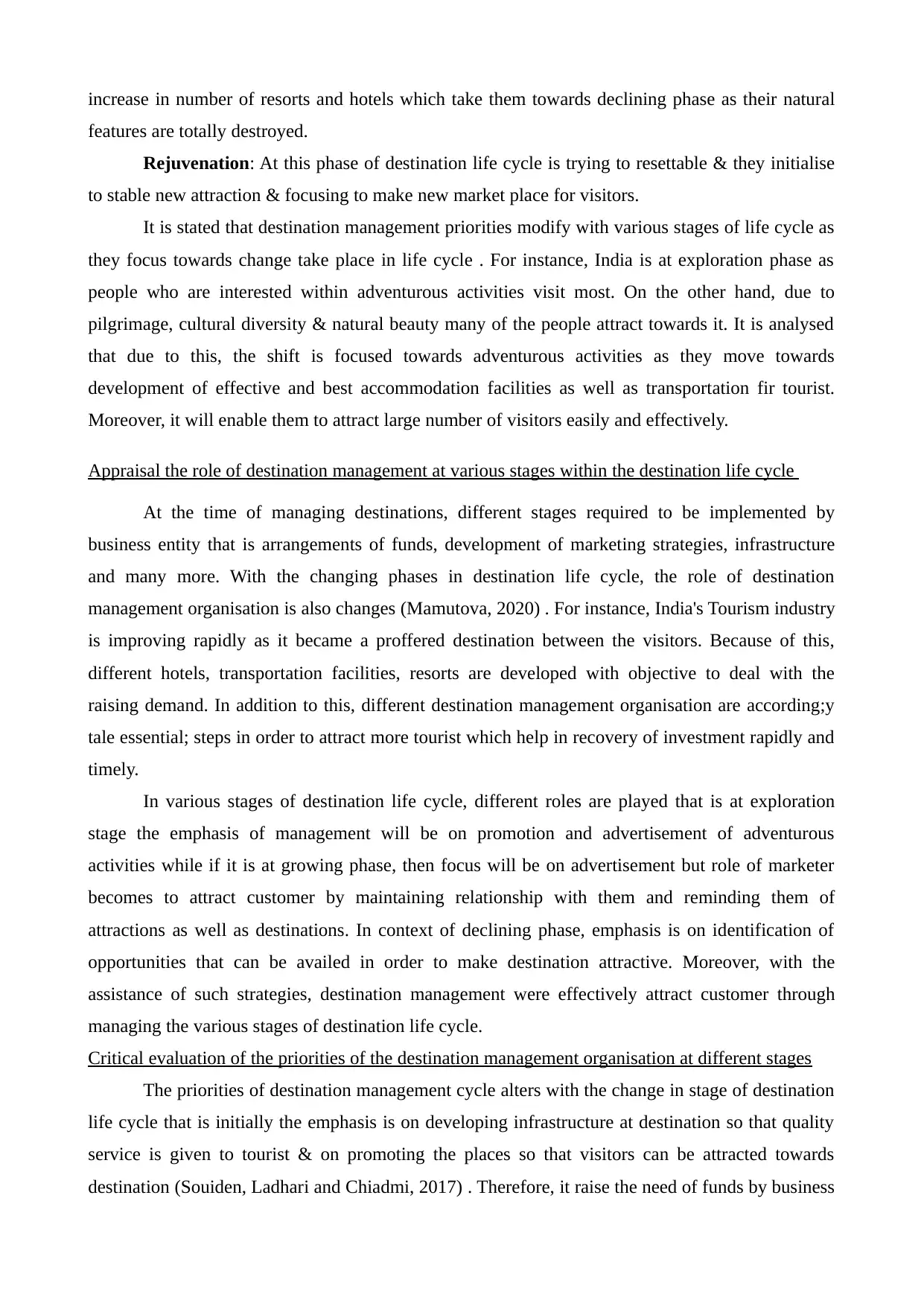
increase in number of resorts and hotels which take them towards declining phase as their natural
features are totally destroyed.
Rejuvenation: At this phase of destination life cycle is trying to resettable & they initialise
to stable new attraction & focusing to make new market place for visitors.
It is stated that destination management priorities modify with various stages of life cycle as
they focus towards change take place in life cycle . For instance, India is at exploration phase as
people who are interested within adventurous activities visit most. On the other hand, due to
pilgrimage, cultural diversity & natural beauty many of the people attract towards it. It is analysed
that due to this, the shift is focused towards adventurous activities as they move towards
development of effective and best accommodation facilities as well as transportation fir tourist.
Moreover, it will enable them to attract large number of visitors easily and effectively.
Appraisal the role of destination management at various stages within the destination life cycle
At the time of managing destinations, different stages required to be implemented by
business entity that is arrangements of funds, development of marketing strategies, infrastructure
and many more. With the changing phases in destination life cycle, the role of destination
management organisation is also changes (Mamutova, 2020) . For instance, India's Tourism industry
is improving rapidly as it became a proffered destination between the visitors. Because of this,
different hotels, transportation facilities, resorts are developed with objective to deal with the
raising demand. In addition to this, different destination management organisation are according;y
tale essential; steps in order to attract more tourist which help in recovery of investment rapidly and
timely.
In various stages of destination life cycle, different roles are played that is at exploration
stage the emphasis of management will be on promotion and advertisement of adventurous
activities while if it is at growing phase, then focus will be on advertisement but role of marketer
becomes to attract customer by maintaining relationship with them and reminding them of
attractions as well as destinations. In context of declining phase, emphasis is on identification of
opportunities that can be availed in order to make destination attractive. Moreover, with the
assistance of such strategies, destination management were effectively attract customer through
managing the various stages of destination life cycle.
Critical evaluation of the priorities of the destination management organisation at different stages
The priorities of destination management cycle alters with the change in stage of destination
life cycle that is initially the emphasis is on developing infrastructure at destination so that quality
service is given to tourist & on promoting the places so that visitors can be attracted towards
destination (Souiden, Ladhari and Chiadmi, 2017) . Therefore, it raise the need of funds by business
features are totally destroyed.
Rejuvenation: At this phase of destination life cycle is trying to resettable & they initialise
to stable new attraction & focusing to make new market place for visitors.
It is stated that destination management priorities modify with various stages of life cycle as
they focus towards change take place in life cycle . For instance, India is at exploration phase as
people who are interested within adventurous activities visit most. On the other hand, due to
pilgrimage, cultural diversity & natural beauty many of the people attract towards it. It is analysed
that due to this, the shift is focused towards adventurous activities as they move towards
development of effective and best accommodation facilities as well as transportation fir tourist.
Moreover, it will enable them to attract large number of visitors easily and effectively.
Appraisal the role of destination management at various stages within the destination life cycle
At the time of managing destinations, different stages required to be implemented by
business entity that is arrangements of funds, development of marketing strategies, infrastructure
and many more. With the changing phases in destination life cycle, the role of destination
management organisation is also changes (Mamutova, 2020) . For instance, India's Tourism industry
is improving rapidly as it became a proffered destination between the visitors. Because of this,
different hotels, transportation facilities, resorts are developed with objective to deal with the
raising demand. In addition to this, different destination management organisation are according;y
tale essential; steps in order to attract more tourist which help in recovery of investment rapidly and
timely.
In various stages of destination life cycle, different roles are played that is at exploration
stage the emphasis of management will be on promotion and advertisement of adventurous
activities while if it is at growing phase, then focus will be on advertisement but role of marketer
becomes to attract customer by maintaining relationship with them and reminding them of
attractions as well as destinations. In context of declining phase, emphasis is on identification of
opportunities that can be availed in order to make destination attractive. Moreover, with the
assistance of such strategies, destination management were effectively attract customer through
managing the various stages of destination life cycle.
Critical evaluation of the priorities of the destination management organisation at different stages
The priorities of destination management cycle alters with the change in stage of destination
life cycle that is initially the emphasis is on developing infrastructure at destination so that quality
service is given to tourist & on promoting the places so that visitors can be attracted towards
destination (Souiden, Ladhari and Chiadmi, 2017) . Therefore, it raise the need of funds by business
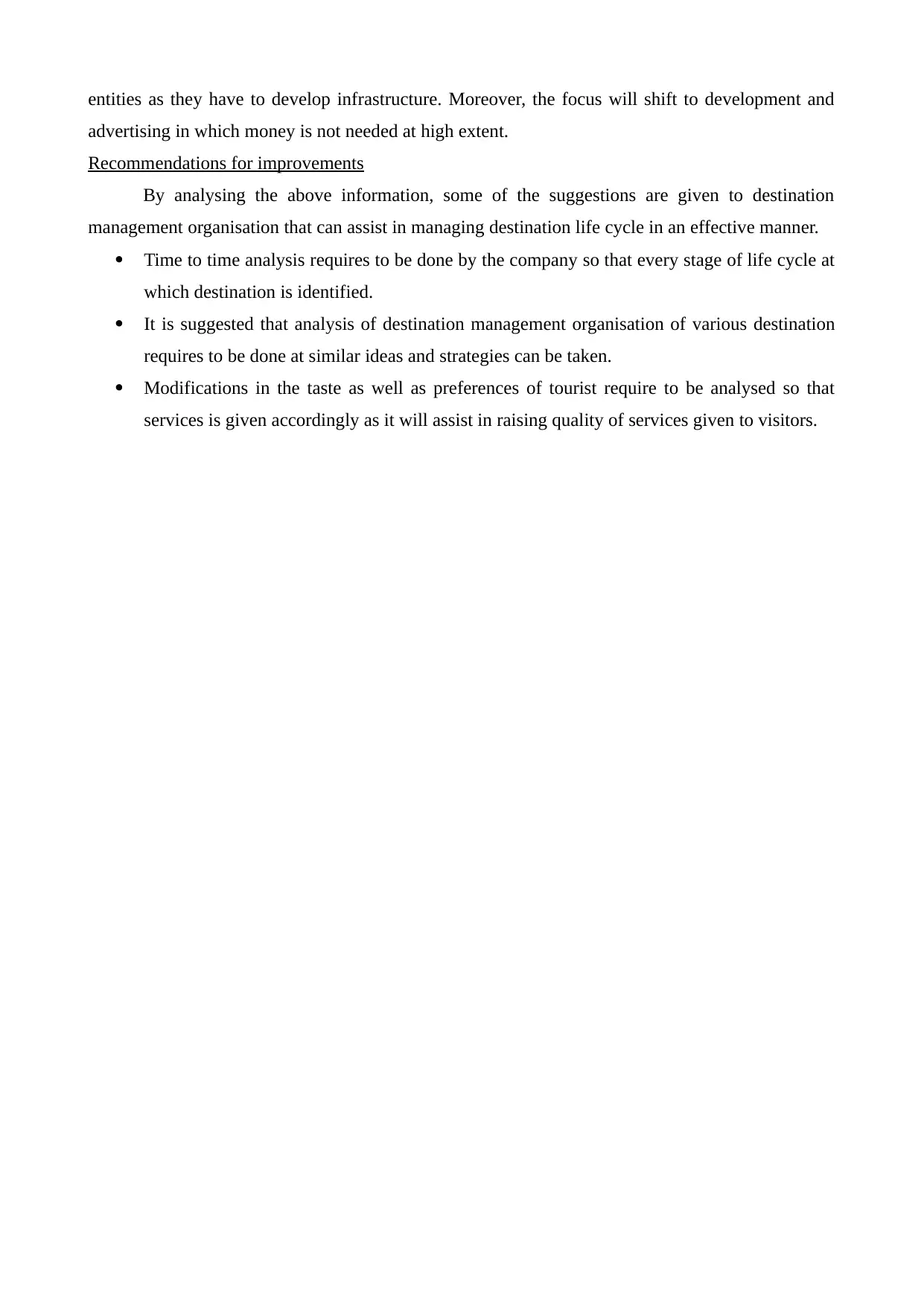
entities as they have to develop infrastructure. Moreover, the focus will shift to development and
advertising in which money is not needed at high extent.
Recommendations for improvements
By analysing the above information, some of the suggestions are given to destination
management organisation that can assist in managing destination life cycle in an effective manner.
Time to time analysis requires to be done by the company so that every stage of life cycle at
which destination is identified.
It is suggested that analysis of destination management organisation of various destination
requires to be done at similar ideas and strategies can be taken.
Modifications in the taste as well as preferences of tourist require to be analysed so that
services is given accordingly as it will assist in raising quality of services given to visitors.
advertising in which money is not needed at high extent.
Recommendations for improvements
By analysing the above information, some of the suggestions are given to destination
management organisation that can assist in managing destination life cycle in an effective manner.
Time to time analysis requires to be done by the company so that every stage of life cycle at
which destination is identified.
It is suggested that analysis of destination management organisation of various destination
requires to be done at similar ideas and strategies can be taken.
Modifications in the taste as well as preferences of tourist require to be analysed so that
services is given accordingly as it will assist in raising quality of services given to visitors.
Paraphrase This Document
Need a fresh take? Get an instant paraphrase of this document with our AI Paraphraser
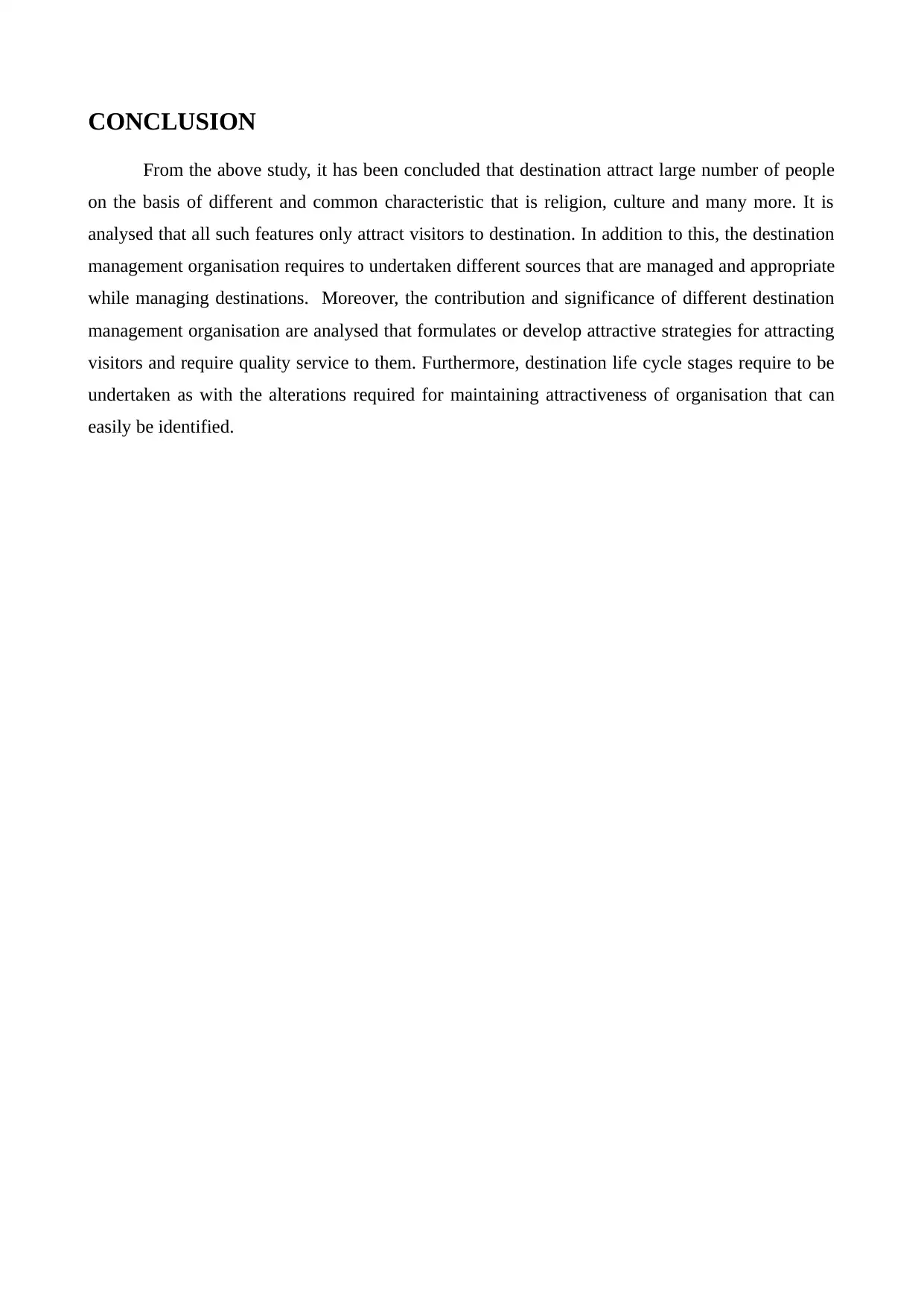
CONCLUSION
From the above study, it has been concluded that destination attract large number of people
on the basis of different and common characteristic that is religion, culture and many more. It is
analysed that all such features only attract visitors to destination. In addition to this, the destination
management organisation requires to undertaken different sources that are managed and appropriate
while managing destinations. Moreover, the contribution and significance of different destination
management organisation are analysed that formulates or develop attractive strategies for attracting
visitors and require quality service to them. Furthermore, destination life cycle stages require to be
undertaken as with the alterations required for maintaining attractiveness of organisation that can
easily be identified.
From the above study, it has been concluded that destination attract large number of people
on the basis of different and common characteristic that is religion, culture and many more. It is
analysed that all such features only attract visitors to destination. In addition to this, the destination
management organisation requires to undertaken different sources that are managed and appropriate
while managing destinations. Moreover, the contribution and significance of different destination
management organisation are analysed that formulates or develop attractive strategies for attracting
visitors and require quality service to them. Furthermore, destination life cycle stages require to be
undertaken as with the alterations required for maintaining attractiveness of organisation that can
easily be identified.
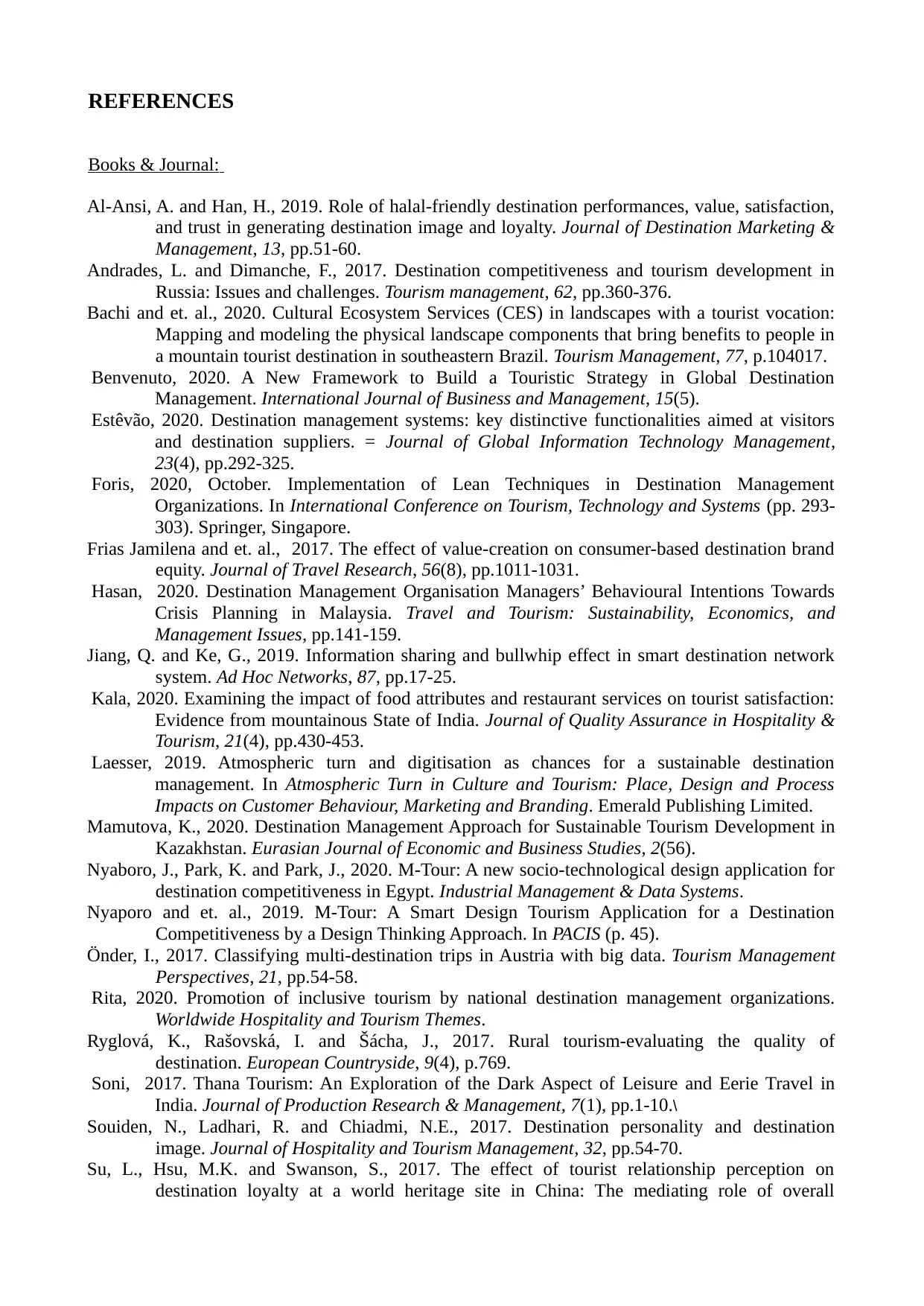
REFERENCES
Books & Journal:
Al-Ansi, A. and Han, H., 2019. Role of halal-friendly destination performances, value, satisfaction,
and trust in generating destination image and loyalty. Journal of Destination Marketing &
Management, 13, pp.51-60.
Andrades, L. and Dimanche, F., 2017. Destination competitiveness and tourism development in
Russia: Issues and challenges. Tourism management, 62, pp.360-376.
Bachi and et. al., 2020. Cultural Ecosystem Services (CES) in landscapes with a tourist vocation:
Mapping and modeling the physical landscape components that bring benefits to people in
a mountain tourist destination in southeastern Brazil. Tourism Management, 77, p.104017.
Benvenuto, 2020. A New Framework to Build a Touristic Strategy in Global Destination
Management. International Journal of Business and Management, 15(5).
Estêvão, 2020. Destination management systems: key distinctive functionalities aimed at visitors
and destination suppliers. = Journal of Global Information Technology Management,
23(4), pp.292-325.
Foris, 2020, October. Implementation of Lean Techniques in Destination Management
Organizations. In International Conference on Tourism, Technology and Systems (pp. 293-
303). Springer, Singapore.
Frias Jamilena and et. al., 2017. The effect of value-creation on consumer-based destination brand
equity. Journal of Travel Research, 56(8), pp.1011-1031.
Hasan, 2020. Destination Management Organisation Managers’ Behavioural Intentions Towards
Crisis Planning in Malaysia. Travel and Tourism: Sustainability, Economics, and
Management Issues, pp.141-159.
Jiang, Q. and Ke, G., 2019. Information sharing and bullwhip effect in smart destination network
system. Ad Hoc Networks, 87, pp.17-25.
Kala, 2020. Examining the impact of food attributes and restaurant services on tourist satisfaction:
Evidence from mountainous State of India. Journal of Quality Assurance in Hospitality &
Tourism, 21(4), pp.430-453.
Laesser, 2019. Atmospheric turn and digitisation as chances for a sustainable destination
management. In Atmospheric Turn in Culture and Tourism: Place, Design and Process
Impacts on Customer Behaviour, Marketing and Branding. Emerald Publishing Limited.
Mamutova, K., 2020. Destination Management Approach for Sustainable Tourism Development in
Kazakhstan. Eurasian Journal of Economic and Business Studies, 2(56).
Nyaboro, J., Park, K. and Park, J., 2020. M-Tour: A new socio-technological design application for
destination competitiveness in Egypt. Industrial Management & Data Systems.
Nyaporo and et. al., 2019. M-Tour: A Smart Design Tourism Application for a Destination
Competitiveness by a Design Thinking Approach. In PACIS (p. 45).
Önder, I., 2017. Classifying multi-destination trips in Austria with big data. Tourism Management
Perspectives, 21, pp.54-58.
Rita, 2020. Promotion of inclusive tourism by national destination management organizations.
Worldwide Hospitality and Tourism Themes.
Ryglová, K., Rašovská, I. and Šácha, J., 2017. Rural tourism-evaluating the quality of
destination. European Countryside, 9(4), p.769.
Soni, 2017. Thana Tourism: An Exploration of the Dark Aspect of Leisure and Eerie Travel in
India. Journal of Production Research & Management, 7(1), pp.1-10.\
Souiden, N., Ladhari, R. and Chiadmi, N.E., 2017. Destination personality and destination
image. Journal of Hospitality and Tourism Management, 32, pp.54-70.
Su, L., Hsu, M.K. and Swanson, S., 2017. The effect of tourist relationship perception on
destination loyalty at a world heritage site in China: The mediating role of overall
Books & Journal:
Al-Ansi, A. and Han, H., 2019. Role of halal-friendly destination performances, value, satisfaction,
and trust in generating destination image and loyalty. Journal of Destination Marketing &
Management, 13, pp.51-60.
Andrades, L. and Dimanche, F., 2017. Destination competitiveness and tourism development in
Russia: Issues and challenges. Tourism management, 62, pp.360-376.
Bachi and et. al., 2020. Cultural Ecosystem Services (CES) in landscapes with a tourist vocation:
Mapping and modeling the physical landscape components that bring benefits to people in
a mountain tourist destination in southeastern Brazil. Tourism Management, 77, p.104017.
Benvenuto, 2020. A New Framework to Build a Touristic Strategy in Global Destination
Management. International Journal of Business and Management, 15(5).
Estêvão, 2020. Destination management systems: key distinctive functionalities aimed at visitors
and destination suppliers. = Journal of Global Information Technology Management,
23(4), pp.292-325.
Foris, 2020, October. Implementation of Lean Techniques in Destination Management
Organizations. In International Conference on Tourism, Technology and Systems (pp. 293-
303). Springer, Singapore.
Frias Jamilena and et. al., 2017. The effect of value-creation on consumer-based destination brand
equity. Journal of Travel Research, 56(8), pp.1011-1031.
Hasan, 2020. Destination Management Organisation Managers’ Behavioural Intentions Towards
Crisis Planning in Malaysia. Travel and Tourism: Sustainability, Economics, and
Management Issues, pp.141-159.
Jiang, Q. and Ke, G., 2019. Information sharing and bullwhip effect in smart destination network
system. Ad Hoc Networks, 87, pp.17-25.
Kala, 2020. Examining the impact of food attributes and restaurant services on tourist satisfaction:
Evidence from mountainous State of India. Journal of Quality Assurance in Hospitality &
Tourism, 21(4), pp.430-453.
Laesser, 2019. Atmospheric turn and digitisation as chances for a sustainable destination
management. In Atmospheric Turn in Culture and Tourism: Place, Design and Process
Impacts on Customer Behaviour, Marketing and Branding. Emerald Publishing Limited.
Mamutova, K., 2020. Destination Management Approach for Sustainable Tourism Development in
Kazakhstan. Eurasian Journal of Economic and Business Studies, 2(56).
Nyaboro, J., Park, K. and Park, J., 2020. M-Tour: A new socio-technological design application for
destination competitiveness in Egypt. Industrial Management & Data Systems.
Nyaporo and et. al., 2019. M-Tour: A Smart Design Tourism Application for a Destination
Competitiveness by a Design Thinking Approach. In PACIS (p. 45).
Önder, I., 2017. Classifying multi-destination trips in Austria with big data. Tourism Management
Perspectives, 21, pp.54-58.
Rita, 2020. Promotion of inclusive tourism by national destination management organizations.
Worldwide Hospitality and Tourism Themes.
Ryglová, K., Rašovská, I. and Šácha, J., 2017. Rural tourism-evaluating the quality of
destination. European Countryside, 9(4), p.769.
Soni, 2017. Thana Tourism: An Exploration of the Dark Aspect of Leisure and Eerie Travel in
India. Journal of Production Research & Management, 7(1), pp.1-10.\
Souiden, N., Ladhari, R. and Chiadmi, N.E., 2017. Destination personality and destination
image. Journal of Hospitality and Tourism Management, 32, pp.54-70.
Su, L., Hsu, M.K. and Swanson, S., 2017. The effect of tourist relationship perception on
destination loyalty at a world heritage site in China: The mediating role of overall

destination satisfaction and trust. Journal of Hospitality & Tourism Research, 41(2),
pp.180-210.
Su, L., Lian, Q. and Huang, Y., 2020. How do tourists' attribution of destination social responsibility
motives impact trust and intention to visit? The moderating role of destination
reputation. Tourism Management, 77, p.103970.
Yoncheva, T. and Hadzhidemirev, S., 2020. Destination management organisation-legal aspects and
perspectives. Agraren Universitet Plovdiv-Nauchni Trudove/Scientific Works of the
Agrarian University-Plovdiv, 62(1), pp.77-82.
pp.180-210.
Su, L., Lian, Q. and Huang, Y., 2020. How do tourists' attribution of destination social responsibility
motives impact trust and intention to visit? The moderating role of destination
reputation. Tourism Management, 77, p.103970.
Yoncheva, T. and Hadzhidemirev, S., 2020. Destination management organisation-legal aspects and
perspectives. Agraren Universitet Plovdiv-Nauchni Trudove/Scientific Works of the
Agrarian University-Plovdiv, 62(1), pp.77-82.
Secure Best Marks with AI Grader
Need help grading? Try our AI Grader for instant feedback on your assignments.



1 out of 19
Related Documents
Your All-in-One AI-Powered Toolkit for Academic Success.
+13062052269
info@desklib.com
Available 24*7 on WhatsApp / Email
![[object Object]](/_next/static/media/star-bottom.7253800d.svg)
Unlock your academic potential
© 2024 | Zucol Services PVT LTD | All rights reserved.





